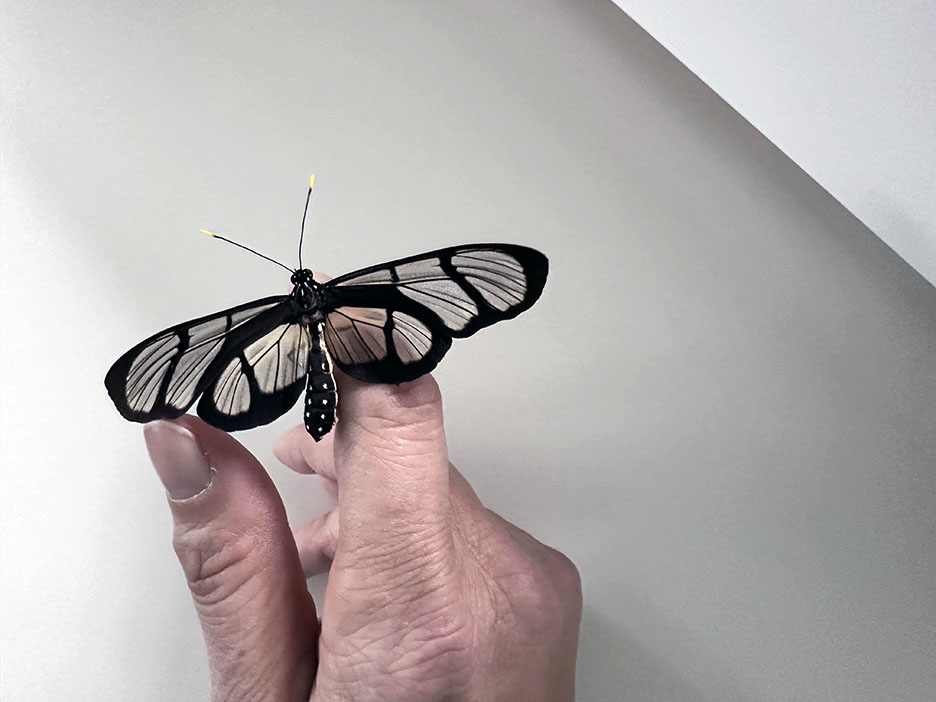
Butterfly Pic, 04072024 edition




This is a giant glasswing butterfly from Ecuador, photographed at Dow Gardens’ Butterflies in Bloom.


The “black and white” butterfly above actually is just barely blue. The blue tiger hails from Asia. Its neighbors here in the chrysalis case are a Doris longwing and a zebra longwing.

These photos were taken March 13, 2024, at Dow Gardens’ Butterflies in Bloom. On Wednesdays during the six-week exhibit, I spend a couple of hours tending the new butterflies in the chrysalis cases. When they are strong enough, they get released to the flying display.

How do they get released? I coax each butterfly onto my hand and transfer it into a mesh “bug catcher” with a zippered top. We also have smaller catchers, but there were a lot to release into the Conservatory this time. They probably would fly out on their own eventually, but I put them either on flowers or eager visitors. Unlike most butterfly exhibits, we encourage interaction, and show people how to hold steady so a butterfly feels safe crawling onto their hand. We do tell visitors not to touch the wings or the food dishes.


Hi from my zebra longwing buddy! We’re at Dow Gardens’ Butterflies in Bloom, where I volunteer on Wednesdays during the annual six-week exhibit, tending the new butterflies in the chrysalis cases. These photos were taken March 6, 2024, from behind the cases.

From the front, the two chrysalis cases in the Conservatory look like windows. From the back, as shown here, they look much the same, except we see much more than visitors do of the blue pads we put down and spray with water to keep the humidity in the cases up.

Here’s a butterfly hanging out on a chrysalis to dry. The best-case scenario is that they emerge quickly and fully, grab their chrysalis firmly, and stay rooted while they flap their wings and pump fluid out of their bodies. The fluid is meconium and stains the pads, so we let concerned visitors know it’s not blood and is completely normal.

A malachite

Most butterflies take a couple of hours to dry and be strong enough for release into the flying display. We need them to be able to fly around to the various flowers and feed themselves.

Our largest butterflies, the owls and blue morphos that are the size of your hand, can take half a day to dry. We let their activity level guide us. When they’re practically beating at the glass, it’s definitely time for release.

With visitors pressing up against the glass all day, it’s impossible to keep clean, sorry. I still like the stained glass effect of the butterflies with the sunlight pouring through.


These are my backyard white turtlehead – in Latin, chelone gabra.
I live in Midland, Michigan, which is USDA Hardiness Zone 6a. In addition, I live in the flat and sandy Saginaw Valley. Much as I would love to grow bird of paradise, to cite just one, it’s not going to happen here.
This year, I have focused on native plants that attract pollinators. The turtlehead – WHITE only, butterflies can be so picky – are said to attract common buckeye and Baltimore checkerspot. I’m familiar with buckeyes from my years tending the emergence case at Dow Gardens‘ Butterflies in Bloom, but never have seen a checkerspot. The turtlehead are among the last bloomers of the year for my yard; the showy goldenrod has not quite burst into glory.




When Butterflies in Bloom extended to Wednesday evenings, it was one of my favorite times to volunteer because the residents would start roosting … cuddling up for bedtime, I would tell young children. This is from the sole Wednesday shift I was able to work this year, around 5 p.m. March 11. No word yet on whether we can open for the last scheduled week of the exhibit.


This butterfly chose the large sculpture in the center of the Conservatory for a resting place.


Sometimes they just get attached. I’ve seen children charmed that a butterfly remains on their clothing or even a finger for 20 minutes. Many, of course, do no such thing. Butterflies in Bloom remains closed through April 5, but at the moment we volunteers still hope to be back at our posts for the two final scheduled weeks.